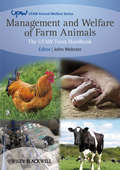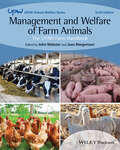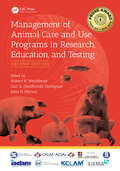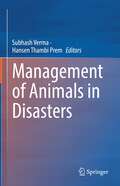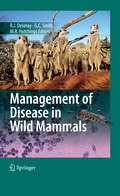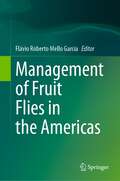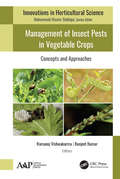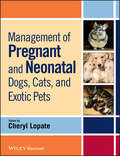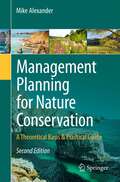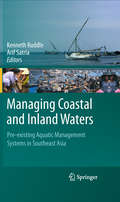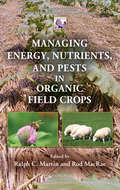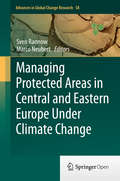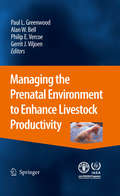- Table View
- List View
Management and Welfare of Farm Animals: The UFAW Farm Handbook (UFAW Animal Welfare #11)
by John WebsterThrough successive editions, Management and Welfare of Farm Animals has gained international recognition as a classic introductory textbook for students of agriculture and veterinary science. Conceived by the Universities Federation for Animal Welfare (UFAW), the book has always sought to promote the humane treatment of livestock within the practical business context of modern farming. Now fully revised and updated, this fifth edition remains the most comprehensive and accessible guide available. Three animal groups appear here for the first time (game birds, South American camelids, and ostriches), and a chapter on horses has also been restored. Throughout, the book offers clear advice for the humane management of all major farmed species in the primary context of large-scale food production. However, this edition also takes full account of consumer demand (and legal requirements) for alternative farming methods and enhanced welfare standards, whether in conventional agriculture or the smallest of ‘hobby' farms. Brand new chapters reflect fresh understanding of welfare science, ethics, and the role of society in ensuring the best possible farm conditions. It remains an indispensable resource for students, and for all those seeking to promote animal welfare. Published as a part of the prestigious Wiley-Blackwell – UFAW Animal Welfare series. UFAW, founded 1926, is an internationally recognised, independent, scientific and educational animal welfare charity. For full details of all titles available in the UFAW series, please visit www.wiley.com/go/ufaw.
Management and Welfare of Farm Animals: The UFAW Farm Handbook (UFAW Animal Welfare #10)
by John Webster Jean MargerisonManagement and Welfare of Farm Animals provides comprehensive and up-to-date information on the humane management of all major farmed species in both large-scale food production and alternative farming systems. Designed for agricultural and veterinary science students, this classic textbook covers the management and welfare of species including dairy and beef cattle, veal calves, sheep, pigs, chickens, turkeys, goats, horses, and farmed fish. The sixth edition incorporates recent developments throughout, including an entirely new chapter on international developments in animal welfare law, politics, and practice. Updated chapters discuss topics such as 'high welfare' livestock systems, the impact of automation and new technologies on production and welfare, the ecological impact and sustainability issues of large-scale production systems, and more. Provides a basic understanding of the principles and practices of professional and humane farm animal management Covers animal husbandry, behavior as an indicator of animal welfare, and the assessment, monitoring, and promotion of improved welfare at the farm level Offers updated information on free-range poultry, robot milking, automated disease scanning, and pastoral systems in the developing world Includes less-common farm species such as South American camelids, ostriches, and game birds Management and Welfare of Farm Animals, Sixth Edition remains the ideal textbook for students in professional, technical, or vocational education courses on the management and welfare of farm animals.
Management and Welfare of Farm Animals: The UFAW Farm Handbook (UFAW Animal Welfare)
Management and Welfare of Farm Animals provides comprehensive and up-to-date information on the humane management of all major farmed species in both large-scale food production and alternative farming systems. Designed for agricultural and veterinary science students, this classic textbook covers the management and welfare of species including dairy and beef cattle, veal calves, sheep, pigs, chickens, turkeys, goats, horses, and farmed fish. The sixth edition incorporates recent developments throughout, including an entirely new chapter on international developments in animal welfare law, politics, and practice. Updated chapters discuss topics such as 'high welfare' livestock systems, the impact of automation and new technologies on production and welfare, the ecological impact and sustainability issues of large-scale production systems, and more. Provides a basic understanding of the principles and practices of professional and humane farm animal management Covers animal husbandry, behavior as an indicator of animal welfare, and the assessment, monitoring, and promotion of improved welfare at the farm level Offers updated information on free-range poultry, robot milking, automated disease scanning, and pastoral systems in the developing world Includes less-common farm species such as South American camelids, ostriches, and game birds Management and Welfare of Farm Animals, Sixth Edition remains the ideal textbook for students in professional, technical, or vocational education courses on the management and welfare of farm animals.
Management of Animal Care and Use Programs in Research, Education, and Testing
by Robert H. Weichbrod Gail A. Heidbrink Thompson John N. NortonAAP Prose Award Finalist 2018/19 Key features - Offers a revised, updated, and comprehensive first-line management book for those working in animal care and use programs who have the responsibility to ensure the welfare of the animals in the highest quality research environment - Serves as an indispensable resource text for certification exams and credentialing boards for a multitude of professional societies - Emphasizes the importance of developing a collaborative culture of care within an animal care and use program and provides information about how behavioral management through animal training can play an integral role in a veterinary health program - Provides a new section on Environment and Housing, containing chapters that focus on management considerations of housing and enrichment delineated by species - Expands coverage of regulatory oversight and compliance, assessment, and assurance issues and processes, including a greater discussion of globalization and harmonizing cultural and regulatory issues - Includes more in-depth treatment throughout the book of critical topics in program management, physical plant, animal health, and husbandry Biomedical research using animals requires administrators and managers who are knowledgeable and highly skilled. They must adapt to the complexity of rapidly-changing technologies, balance research goals with a thorough understanding of regulatory requirements and guidelines, and know how to work with a multi-generational, multi-cultural workforce. Management of Animal Care and Use Programs in Research, Education, and Testing, Second Edition is the extensively expanded revision of the popular Management of Laboratory Animal Care and Use Programs book published earlier this century. Following in the footsteps of the first edition, this revision serves as a first line management resource, providing for strong advocacy for advancing quality animal welfare and science worldwide, and continues as a valuable seminal reference for those engaged in all types of programs involving animal care and use. It has more than doubled the number of chapters in the original volume to present a more comprehensive overview of the current breadth and depth of the field with applicability to an international audience. Readers are provided with the latest information and resource and reference material from authors who are noted experts in their field. Co-publishers on the second edition are: ACLAM (American College of Laboratory Animal Medicine); ECLAM (European College of Laboratory Animal Medicine); IACLAM (International Colleges of Laboratory Animal Medicine); JCLAM (Japanese College of Laboratory Animal Medicine); KCLAM (Korean College of Laboratory Animal Medicine); CALAS (Canadian Association of Laboratory Animal Medicine); LAMA (Laboratory Animal Management Association); and IAT (Institute of Animal Technology).
Management of Animal Care and Use Programs in Research, Education, and Testing
by Robert H. Weichbrod Gail A. Heidbrink Thompson John N. NortonAAP Prose Award Finalist 2018/19 Key features - Offers a revised, updated, and comprehensive first-line management book for those working in animal care and use programs who have the responsibility to ensure the welfare of the animals in the highest quality research environment - Serves as an indispensable resource text for certification exams and credentialing boards for a multitude of professional societies - Emphasizes the importance of developing a collaborative culture of care within an animal care and use program and provides information about how behavioral management through animal training can play an integral role in a veterinary health program - Provides a new section on Environment and Housing, containing chapters that focus on management considerations of housing and enrichment delineated by species - Expands coverage of regulatory oversight and compliance, assessment, and assurance issues and processes, including a greater discussion of globalization and harmonizing cultural and regulatory issues - Includes more in-depth treatment throughout the book of critical topics in program management, physical plant, animal health, and husbandry Biomedical research using animals requires administrators and managers who are knowledgeable and highly skilled. They must adapt to the complexity of rapidly-changing technologies, balance research goals with a thorough understanding of regulatory requirements and guidelines, and know how to work with a multi-generational, multi-cultural workforce. Management of Animal Care and Use Programs in Research, Education, and Testing, Second Edition is the extensively expanded revision of the popular Management of Laboratory Animal Care and Use Programs book published earlier this century. Following in the footsteps of the first edition, this revision serves as a first line management resource, providing for strong advocacy for advancing quality animal welfare and science worldwide, and continues as a valuable seminal reference for those engaged in all types of programs involving animal care and use. It has more than doubled the number of chapters in the original volume to present a more comprehensive overview of the current breadth and depth of the field with applicability to an international audience. Readers are provided with the latest information and resource and reference material from authors who are noted experts in their field. Co-publishers on the second edition are: ACLAM (American College of Laboratory Animal Medicine); ECLAM (European College of Laboratory Animal Medicine); IACLAM (International Colleges of Laboratory Animal Medicine); JCLAM (Japanese College of Laboratory Animal Medicine); KCLAM (Korean College of Laboratory Animal Medicine); CALAS (Canadian Association of Laboratory Animal Medicine); LAMA (Laboratory Animal Management Association); and IAT (Institute of Animal Technology).
Management of Animals in Disasters
by Subhash Verma Hansen Thambi PremThis book is a comprehensive guide for veterinary and humanitarian professionals to plan emergency responses for the care and welfare of animals. It covers various topics on disasters, such as principles of disaster management, operation planning, team deployment, etc., from the perspective of saving both livestock and the livelihood of vulnerable communities. The book also discusses the importance of early warning systems, biosecurity, techniques for data collection, one health approach, climate change, and appropriate mitigation strategies. It highlights different principles, approaches, and guidelines related to the rescue, relief, and management of animals during disasters. It also contains topics on the welfare of birds and the rescue and relief of wild animals. This book includes essential veterinary and life-saving supplies required by the relief providing teams during emergencies such as disasters. The book helps administrators understand the key aspects of welfare and management of animals during disasters and enable them to draft policies focusing on humans and animals’ rescue & welfare and protection of livelihoods. It is an essential guide for veterinarians, humanitarian workers, field functionaries, farmers, disaster response forces personnel, etc., during various types of disasters and emergencies.
Management of Disease in Wild Mammals
by Richard Delahay Graham C. Smith Michael R. HutchingsIn recent years nobody could have failed to notice the frequent and often sensati- alist media headlines warning of the latest global disease threat to humankind. But behind all the hyperbole lie real challenges related to dealing with the increasing incidence of emerging zoonotic disease events, the majority of which are thought to originate in wildlife (Jones et al. 2008). There are also many important diseases of domestic livestock which also occur in wildlife (e. g. foot and mouth disease and classical swine fever in wild boar, bovine tuberculosis in deer, badgers or possums), some of which can have a devastating impact on the farming industry, the wider rural economy and ultimately the public purse. But we should also not forget that wildlife diseases may have serious implications for the conservation of biodiversity. For some of the rarest, most endangered species (such as the Ethiopian wolf) d- ease may pose the greatest threat to their survival. If we are to avoid or reduce these impacts then we must improve our ability to detect and manage the risks associated with disease in wildlife populations. This is a challenge that will require expertise from many different disciplines: veterinary, ecological, medical, economic, poli- cal and zoological. In such an interdisciplinary field it is difficult to stay up to date with contemporary ideas and with techniques that may be rapidly evolving.
The Management of Enclosed and Domesticated Deer: International Husbandry Systems and Diseases
by John FletcherThis is the first book devoted to international deer husbandry techniques for the growing industries of venison, velvet antler, and antler trophy production as well as long established extensive park systems for amenity. Written by world leaders in their specialised subjects, chapters shed light on widely differing management systems and the optimum design of deer farms, handling yards and fencing layouts. Moreover, readers will discover the requisites of good stockmanship and specialist veterinarians describe different diseases the deer may develop. Details on available treatments, the general biology of deer and an explanation of controversial ethics of velvet and trophy production complete this work.As deer farming has come of age this collection is timely. At fifty years the New Zealand deer industry carries one million animals with annual venison exports to America, Europe and growing antler markets in China and Korea. Chinese antler production is well-established and Asian reindeer husbandry even more ancient. In North America and Europe, deer are now being kept for antler trophies and amenity in many historic parks. This volume is a valuable resource for everyone researching deer management systems, be it practising veterinarians, deer farmers, park managers or agricultural and veterinary students.
Management of Fruit Flies in the Americas
by Flávio Roberto Mello GarciaThis book comprises issues at the cutting edge of fruit fly management in the Americas, covering topics that are focal points of current activity and likely long-term importance to the progress of the field. The book is an invaluable source of ideas and inspiration for entomologists at all levels from graduate students to more-established researchers and professionals. Fruit flies (Diptera, Tephritidae) is the most important pests of fruit production worldwide. The purpose of this book is to integrate the experiences of leading scientists in the management of fruit flies in the Americas. In this work, species of fruit flies of economic importance are considered in the genera Anastrepha, Rhagoletis, Bactrocera, and Ceratitis. This book will address fruit flies monitoring, biological control, chemical control, cultural control, sterile insect technique (SIT), Integrated Pest Management (IPM), and other control methods. The book provides invaluable resource material to scientists, professionals and students.
Management of Insect Pests in Vegetable Crops: Concepts and Approaches
by Ramanuj Vishwakarma; Ranjeet KumarThis new book on the sustainable management of insect pests in important vegetables offers valuable management strategies in detail. It focuses on eco-friendly technology and approaches to mitigating the damage caused by insect pests with special reference to newer insecticides. Chapters in the volume provide an introduction to vegetable entomology and go on to present a plethora of research on sustainable eco-friendly pest management strategies for root vegetables, spice crops, tuber crops, and more.Vegetable crops that are infested by several insect pests from the nursery to the harvesting stage cause enormous crop losses. Given that it is estimated that up to 40 percent of global crops are lost to agricultural pests each year, new research on effective management strategies is vital. The valuable information provided in this book will be very helpful for faculty and advanced-level students, scientists and researchers, policymakers, and others involved in pest management for vegetable crops.
Management of Insect Pests in Vegetable Crops: Concepts and Approaches
by Ramanuj Vishwakarma Ranjeet KumarThis new book on the sustainable management of insect pests in important vegetables offers valuable management strategies in detail. It focuses on eco-friendly technology and approaches to mitigating the damage caused by insect pests with special reference to newer insecticides. Chapters in the volume provide an introduction to vegetable entomology and go on to present a plethora of research on sustainable eco-friendly pest management strategies for root vegetables, spice crops, tuber crops, and more.Vegetable crops that are infested by several insect pests from the nursery to the harvesting stage cause enormous crop losses. Given that it is estimated that up to 40 percent of global crops are lost to agricultural pests each year, new research on effective management strategies is vital. The valuable information provided in this book will be very helpful for faculty and advanced-level students, scientists and researchers, policymakers, and others involved in pest management for vegetable crops.
Management of Insect Pests to Agriculture: Lessons Learned from Deciphering their Genome, Transcriptome and Proteome
by Henryk Czosnek Murad GhanimThanks to the application of new technologies such as whole-genome sequencing, analysis of transcriptome and proteome of insect pest to agriculture, great progress has been made in understanding the life style, reproduction, evolution and nuisance to crops caused by insect pests such as aphids, planthoppers, and whiteflies. We believe that time has come to summarize progress and to have a glance over the horizon. In this Book experts in the field discuss novel means to increase the different kinds of resistances of plants to better limit the effects of pest, to understand and disturb the hormonal regulation of embryogenesis, molting, metamorphosis and reproduction, to determine the function of insect genes in diverse processes such as metabolism, interaction with plants, virus transmission, development, and adaptation to a changing environment. The knowledge presented here is discussed with the aim of further improving control strategies of insect pestsman";mso-hansi-theme-font:minor-bidi;mso-bidi-theme-font:minor-bidi; mso-ansi-language:NL;mso-fareast-language:NL;mso-bidi-language:AR-SA">.
Management of Pregnant and Neonatal Dogs, Cats, and Exotic Pets
by Cheryl LopateManagement of Pregnant and Neonatal Dogs, Cats, and Exotic Pets is a comprehensive yet practical reference on small animal neonatology. Covering reproductive physiology of pregnancy and parturition, normal neonatology, and neonatal disorders in dogs, cats, and small exotic mammals, the book gives special emphasis to fetal well-being, parturition, normal physical parameters, behavior, common disorders and defects, emergency care, and orphan management. Information on nutritional and environmental considerations for both the dam and offspring is included, as well as guidance on offering advice to breeders providing neonatal care at home. Well illustrated throughout, Management of Pregnant and Neonatal Dogs, Cats, and Exotic Pets is a complete resource for the successful management of pregnant and newborn pets. Veterinary practitioners, students, technicians, and professional breeders all will find the book’s how-to, clinically relevant approach to small animal neonatology invaluable.
Management of Pregnant and Neonatal Dogs, Cats, and Exotic Pets
by Cheryl LopateManagement of Pregnant and Neonatal Dogs, Cats, and Exotic Pets is a comprehensive yet practical reference on small animal neonatology. Covering reproductive physiology of pregnancy and parturition, normal neonatology, and neonatal disorders in dogs, cats, and small exotic mammals, the book gives special emphasis to fetal well-being, parturition, normal physical parameters, behavior, common disorders and defects, emergency care, and orphan management. Information on nutritional and environmental considerations for both the dam and offspring is included, as well as guidance on offering advice to breeders providing neonatal care at home. Well illustrated throughout, Management of Pregnant and Neonatal Dogs, Cats, and Exotic Pets is a complete resource for the successful management of pregnant and newborn pets. Veterinary practitioners, students, technicians, and professional breeders all will find the book’s how-to, clinically relevant approach to small animal neonatology invaluable.
Management of Small Animal Distal Limb Injuries
by Steven F. Swaim Janet A. Welch Robert L. GilletteSmall Animal Distal Limb Injuries provide the small and mixed animal practitioner with a definitive but practical, step-by-step guide to the management of soft tissue, orthopedic and athletic injuries of the distal limbs in dogs and cats.Includes specific coverage of injuries that occur from the carpal/tarsal areas to the digits of dogs and cats. A
Management Planning for Nature Conservation: A Theoretical Basis & Practical Guide
by Mike AlexanderThe first edition of Mike Alexander’s Management Planning for Nature Conservation, brought a new dimension to the modern literature on conservation management. This second edition, a significant enhancement of the original, deals with the development both, conceptual and practical, of adaptive management planning for nature conservation. It is about preparing management plans, and guides the reader through the entire process. Case-studies, including a conservation and access plan, demonstrate the planning process in action. This approach to planning can be applied to any place which is managed entirely, or in part, for wildlife. It can be applied to the management of species or habitats in any circumstance, regardless of site designation. The process is fully compatible with the Convention on Biological Diversity’s ‘ecosystem approach’ to conservation management.Mike Alexander has long been at the forefront of developing management planning for conservation, with experience ranging from Uganda to Estonia, and from Costa Rica to Wales. He is the General Secretary of the Conservation Management System Consortium, a group of organisations with a common aim of raising standards and developing best practice in conservation management and planning. In 2012 Mike Alexander was elected a Fellow of the Society of Biology in recognition of his contribution to nature conservation and in particular management planning.This book has drawn on the experiences and expertise of the CMS consortium and other leaders in both conservation research and wildlife management from around the world. It is essential reading for professional conservation managers and any student studying management planning for conservation within a range of degree and postgraduate courses.
Managing and Designing Landscapes for Conservation: Moving from Perspectives to Principles
by David B. Lindenmayer Richard J. HobbsThe distinctive relationships between landscape change, habitat fragmentation, and biodiversity conservation are highlighted in this original and useful guide to the theory and practice of ecological landscape design. Using original, ecologically based landscape design principles, the text underscores current thinking in landscape management and conservation. It offers a blend of theoretical and practical information that is illustrated with case studies drawn from across the globe. Key insights by some of the world’s leading experts in landscape ecology and conservation biology make Managing and Designing Landscapes for Conservation an essential volume for anyone involved in landscape management, natural resource planning, or biodiversity conservation.
Managing Coastal and Inland Waters: Pre-existing Aquatic Management Systems in Southeast Asia
by Kenneth Ruddle Arif SatriaBesides the erroneous assumption that tropical fisheries are ‘open access’, the cases demonstrate that pre-existing systems (1) are concerned with the community of fishers and ensuring community harmony and continuity; (2) involve flexible, multiple and overlapping rights adapted to changing needs and circumstances; (3) that fisheries are just one component of a community resource assemblage and depend on both the good management of linked upstream ecosystems and risk management to ensure balanced nutritional resources of the community; and (4) pre-existing systems are greatly affected by a constellation of interacting external pressures.
Managing Energy, Nutrients, and Pests in Organic Field Crops
The use of organic management practices in field cropping continues to rise globally, and these methods have proven to be a viable way to produce food with reduced resource use and environmental damage. Managing Energy, Nutrients, and Pests in Organic Field Crops challenges the popular misconception that organic systems are weak at managing energy,
Managing Pasture: A Complete Guide to Building Healthy Pasture for Grass-Based Meat & Dairy Animals
by Dale StricklerThis in-depth handbook to improving pasture quality and soil health guides farmers seeking to establish sustainable, profitable grass-based livestock operations.
Managing Protected Areas in Central and Eastern Europe Under Climate Change (Advances in Global Change Research #58)
by Sven Rannow Marco NeubertBeginning with an overview of data and concepts developed in the EU-project HABIT-CHANGE, this book addresses the need for sharing knowledge and experience in the field of biodiversity conservation and climate change. There is an urgent need to build capacity in protected areas to monitor, assess, manage and report the effects of climate change and their interaction with other pressures. The contributors identify barriers to the adaptation of conservation management, such as the mismatch between planning reality and the decision context at site level. Short and vivid descriptions of case studies, drawn from investigation areas all over Central and Eastern Europe, illustrate both the local impacts of climate change and their consequences for future management. These focus on ecosystems most vulnerable to changes in climatic conditions, including alpine areas, wetlands, forests, lowland grasslands and coastal areas. The case studies demonstrate the application of adaptation strategies in protected areas like National Parks, Biosphere Reserves and Natural Parks, and reflect the potential benefits as well as existing obstacles. A general section provides the necessary background information on climate trends and their effects on abiotic and biotic components. Often, the parties to policy change and conservation management, including managers, land users and stakeholders, lack both expertise and incentives to undertake adaptation activities. The authors recognise that achieving the needed changes in behavior – habit – is as much a social learning process as a matter of science-based procedure. They describe the implementation of modeling, impact assessment and monitoring of climate conditions, and show how the results can support efforts to increase stakeholder involvement in local adaptation strategies. The book concludes by pointing out the need for more work to communicate the cross-sectoral nature of biodiversity protection, the value of well-informed planning in the long-term process of adaptation, the definition of acceptable change, and the motivational value of exchanging experience and examples of good practice.
Managing the Laboratory Animal Facility
by Jerald SilvermanPraise for the Previous Editions "The author brings in management wisdom from the world outside laboratory animal medicine and veterinary medicine. As a result, there is a rich mixture of the experience of a seasoned professional and the theoretical framework used by schools of management …. I recommend this book to managers and laboratory animal specialists at any stage of their careers." —Franklin M. Loew, DVM, PhD, DACLAM, JAVMA, Vol. 222, No. 6, 2003 "… This book is a good informational resource for any new manager to the field of laboratory management. The information is presented in a way that will keep your interest and stimulate you to think how it can benefit you and the facility in which you work." —Susan K. Cutter, BS, RVT, RLATG, Purdue University, West Lafayette, Indiana, USA, LAMA Review Written in Jerry Silverman’s trademark style, Managing the Laboratory Animal Facility, Third Edition provides the reader with sound management theory and associated management practices that are easy to read, easy to understand, easy to implement, and pertinent to the daily management and leadership of laboratory animal facilities. Maintaining the practical focus of previous editions, this greatly expanded volume presents the critical knowledge needed to help you make efficient and effective use of the key resources that are used every day by vivarium managers – people, time, money, and information. New to the Third Edition Incorporating the latest developments in management theory and application, the edition contains approximately 100 pages of new and expanded material. This more detailed coverage: Discusses lean management concepts and practices and their application to laboratory animal science Adds information on many essential topics, especially in human resources management in its treatment of negotiations, influence, and performance reviews Provides a large number of revisions and updates to Appendix 2 in its presentation of Per diem calculations Includes an extensive list of references for further study of specialized topics
Managing the Laboratory Animal Facility
by Jerald SilvermanPraise for the Previous Editions "The author brings in management wisdom from the world outside laboratory animal medicine and veterinary medicine. As a result, there is a rich mixture of the experience of a seasoned professional and the theoretical framework used by schools of management …. I recommend this book to managers and laboratory animal specialists at any stage of their careers." —Franklin M. Loew, DVM, PhD, DACLAM, JAVMA, Vol. 222, No. 6, 2003 "… This book is a good informational resource for any new manager to the field of laboratory management. The information is presented in a way that will keep your interest and stimulate you to think how it can benefit you and the facility in which you work." —Susan K. Cutter, BS, RVT, RLATG, Purdue University, West Lafayette, Indiana, USA, LAMA Review Written in Jerry Silverman’s trademark style, Managing the Laboratory Animal Facility, Third Edition provides the reader with sound management theory and associated management practices that are easy to read, easy to understand, easy to implement, and pertinent to the daily management and leadership of laboratory animal facilities. Maintaining the practical focus of previous editions, this greatly expanded volume presents the critical knowledge needed to help you make efficient and effective use of the key resources that are used every day by vivarium managers – people, time, money, and information. New to the Third Edition Incorporating the latest developments in management theory and application, the edition contains approximately 100 pages of new and expanded material. This more detailed coverage: Discusses lean management concepts and practices and their application to laboratory animal science Adds information on many essential topics, especially in human resources management in its treatment of negotiations, influence, and performance reviews Provides a large number of revisions and updates to Appendix 2 in its presentation of Per diem calculations Includes an extensive list of references for further study of specialized topics
Managing the Prenatal Environment to Enhance Livestock Productivity
by Paul L. Greenwood Philip E. Vercoe Alan W. Bell Gerritt J. ViljoenPrenatal life is the period of maximal development in animals, and it is well recognised that factors that alter development can have profound effects on the embryonic, fetal and postnatal animal. Scientists involved in research on livestock productivity have for decades studied postnatal consequences of fetal development on productivity. Recently, however, there has been a surge in interest in how to manage prenatal development to enhance livestock health and productivity. This has occurred largely due to the studies that show human health in later life can be influenced by events during prenatal life, and establishment of the Fetal Origins and the Thrifty Phenotype Hypotheses. This book, Managing the Prenatal Environment to Enhance Livestock Productivity reviews phenotypic consequences of prenatal development, and provides details of mechanisms that underpin these effects in ruminants, pigs and poultry. The chapters have been divided into three parts: Quantification of prenatal effects on postnatal productivity, mechanistic bases of postnatal consequences of prenatal development and regulators of fetal and neonatal nutrient supply. Managing the Prenatal Environment to Enhance Livestock Productivity is a reference from which future research to improve the level of understanding and capacity to enhance productivity, health and efficiency of livestock in developing and developed countries will evolve. It is particularly timely given the development of molecular technologies that are providing new insight into regulation and consequences of growth and development of the embryo, fetus and neonate.
Managing Turfgrass Pests
by Thomas L. Watschke Peter H. Dernoeden David J. ShetlarWritten by three of the top professionals in the turfgrass field, Managing Turfgrass Pests, Second Edition brings together hundreds of solutions and best practices to help you manage turfgrass weeds, diseases, and insects more effectively. Since the publication of the bestselling first edition, advances in pest-resistant turfgrass cultivars and pes
